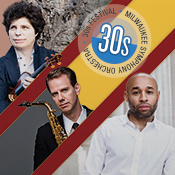
Saxophonist Timothy McAllister Joins the MSO for All That Jazz
David Lewellen
PUBLISHED
Tagged Under: 2021.22 Season, Guest Artist
When Timothy McAllister performs a saxophone concerto with an orchestra, he isn’t just concentrating on giving a good performance. He also feels the need to convince audiences that the saxophone is a classical instrument.
“People will be there who have never heard a saxophone played like this,” said McAllister, who will perform two solo works in this weekend’s Milwaukee Symphony concerts. “I have to be an advocate for the instrument, and I have to maintain the standard of whatever great violinist or pianist played there the week before.”
The saxophone, which has been a mainstay of jazz and pop music for more than a century, has never quite made it into the mainstream of classical composition. No orchestra carries a dedicated saxophonist on its roster. McAllister gets hired frequently for single weeks, but “it’s not a full-time job playing Bolero or Pictures at an Exhibition,” he said, referring to popular pieces with prominent sax parts.
McAllister’s appearance is part of the MSO’s 1930s festival, to honor the decade in which the Warner Theater (now the Bradley Symphony Center) opened. In the history of classical music, the 1930s still count as modern to most people, but “our instrument evolved so quickly that we tend to see that as the classic period.”
The works by Erwin Schulhoff and Jacques Ibert that he will perform certainly fit the cultural milieu of the era. Schulhoff, a German-Czech Jew, died in a World War II concentration camp, and his music, along with the saxophone itself, was considered “degenerate art” by the Nazis. Ibert, like many French composers of his generation, was influenced by jazz, and his Concertino da Camera is “a masterpiece in our literature,” McAllister said. “Its challenges push me to this day.” He hasn’t played it with a professional orchestra since 2006, and “it was hard then and it’s hard now.”
In college and graduate school, “the saxophone was the vehicle for my artistic expression,” McAllister said. But like any ambitious young musician, “your path can lead you in any direction, and you have to be prepared to pivot. Hardly anyone gets to make a living as a soloist” – which is particularly true for saxophonists. McAllister can name a lot of conductors and arts administrators who started on his instrument, and he himself thought about a career in conducting. But his path took him to the University of Michigan, where he is professor of saxophone, and he also performs as a freelancer.
One way to get more performing opportunities is to convince composers to write for the instrument, and the social upheavals of 2020 are indirectly benefiting the saxophone. As orchestras re-assess their programming, “diversity of voices also comes with diversity of instrumentation,” McAllister said. “Young composers of color see instruments other than the violin or cello.” He looked around many symphonies’ season announcements for 2021-22, and said of the living composers, “I know all of these people; I’ve been working with them for years. It’s nice to see orchestras catch up.”
McAllister last soloed with the MSO in 2014, performing the concerto that John Adams wrote for him. As a teenager in Houston, he saw the 1987 world premiere production of Adams’ opera Nixon in China, with his teacher playing one of the four saxophone parts in the orchestra, “and that’s when I realized what I wanted to do with my life. John is a little embarrassed when I tell him that his music led me down this path.”
There is a big difference, however, between soloing and sitting in the woodwind section for pieces that happen to call for a saxophone – which McAllister has also done in the past for the MSO. The practice of asking a full-time clarinetist to double on the instrument is becoming rarer, McAllister said, but when he joins an orchestra for one week, “you immediately have to embed yourself in the culture of the group. Every orchestra is different. The pressure is on us to show up and lay it down.”


